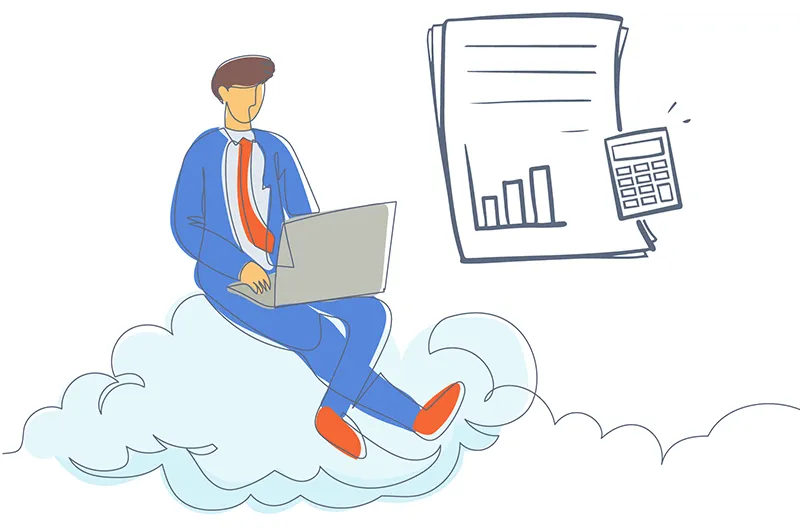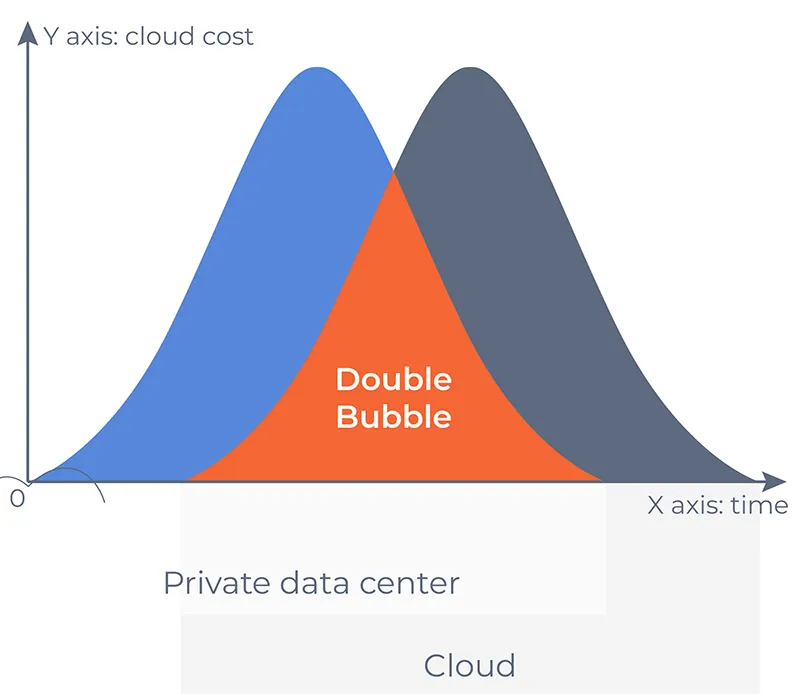
The “double bubble” concept is crucial in cloud migration and digital transformation. I read an insightful article by the Intuit engineering team some time ago highlighting this challenge. The “double bubble” happens when businesses pay for their source and target environments during a migration. This overlapping expense can put a strain on budgets if not handled carefully. Let’s explain how often this happens and how to avoid it effectively.
The four key stages of a standard cloud migration project
Justifying the IT and business needs
The process starts by clearly establishing why the migration is necessary. The justification drives the project forward: avoid vendor lock-in, address hardware or software renewals, scale operations faster, or leverage public cloud discounts. With strong reasons, gaining stakeholder approval becomes straightforward.
Defining the project scope
In this phase, the project manager takes charge, and the team identifies specific applications, workloads, and resources for migration.
Executing the migration
In this phase, the project manager takes charge, and the team identifies specific applications, workloads, and resources for migration.
Conducting a post-mortem review
After the migration, the team evaluates the project’s success, identifies lessons learned, and fine-tunes the new cloud setup to optimize costs and performance.
By tackling each stage with clear planning and execution, businesses can reduce the risk of double bubble costs and make their cloud migration smoother and more efficient.
During phases two and three of cloud migration, businesses often manage resources running in source and target environments. Some resources have migrated, others are still in the queue, and some continue operating solely on the source cloud. The main challenge occurs when businesses move resources—sometimes hundreds or thousands of machines—and incur double costs.
Effective cost management hinges on optimization and tracking. By implementing structured policies, principles, and processes, businesses can maintain control over their cloud expenditures and satisfy stakeholders. If cloud bills are consistently surprising, it’s likely due to underutilized cost governance tools.
Organizations planning cloud migrations often categorize resources by applications, departments, or workloads. Experts recommend splitting these into smaller, manageable chunks of 30–50 virtual machines (VMs) and migrating in phases. This approach reduces risks and directly addresses the bubble effect. Keeping a single application within a chunk allows teams to migrate, test, and validate it as a complete system, reducing potential issues like data locality conflicts. It’s crucial to account for cross-region and outbound cloud traffic costs, which can significantly impact the final bill.
These phases result in temporary storage, computing, and resource costs in both environments. Test migrations typically take 1–3 weeks (or longer), during which the application’s team validates its functionality and performance. Migrating multiple chunks in parallel amplifies these costs, causing the bubble to grow.
Careful planning, resource optimization, and efficient testing processes are essential to minimizing the double bubble effect and ensuring a smoother and more cost-effective migration.

Practical steps to minimize the double bubble effect in cloud migration
Avoiding the double bubble during a cloud migration requires careful planning, precise execution, and effective communication. While some overlap is inevitable, by taking these actions, you can significantly decrease the operational and budgetary effects:
Assess your migration pace
Be realistic about your migration speed. Like mastering a new skill, it starts slowly but improves after a few iterations. Understanding your pace helps you set achievable milestones.
Organize a migration queue
Identify the applications or chunks to migrate and establish a precise sequence. Map these onto a migration project calendar to maintain a structured workflow.
Optimize replication processes
Choose tools replicating virtual machines (VMs) without downtime or frequent re-replication. These tools save time and storage costs by reducing redundant operations.
Engage with application teams
Communicate early with the teams managing the applications or chunks being migrated. Define acceptance criteria and establish the cutover process well in advance. Ensure they allocate specific times for testing, as unprepared teams often cause delays, driving up costs.
Set a waiting period
Determine how long migrated VMs remain in the source environment as a backup. While backups are necessary for risk mitigation, remember that they incur additional costs, so strike a balance.
Manage testing efficiency
Monitor the testing phase closely. If a team lacks preparation or prioritization, pause the tests to prevent wasted resources. Engage their managers or upper management to realign priorities. Delays in testing or poorly made decisions can result in higher costs or unforeseen issues.
Execute the cutover
Once tests are successful, proceed with the cutover. Remove all snapshots and test migrations for the applications. Start the waiting period for these resources and finalize the transition.
Adjust based on progress
Revisit your initial migration pace regularly and adjust your schedule. Iterative improvements can refine the process and reduce costs in future phases.
Final thoughts
Every migration project will encounter some degree of a double bubble, but its size depends on the quality of planning and communication. Brave individuals may attempt a complete infrastructure migration in one go, but the more innovative approach involves phased migrations broken into manageable chunks. By adopting a strategic plan and engaging stakeholders early, you can control the bubble and ensure a smoother, more cost-efficient cloud transition.
You may find this article valuable for you. Learn how to optimize AWS S3 storage with Duplicate Object Finder by OptScale →


